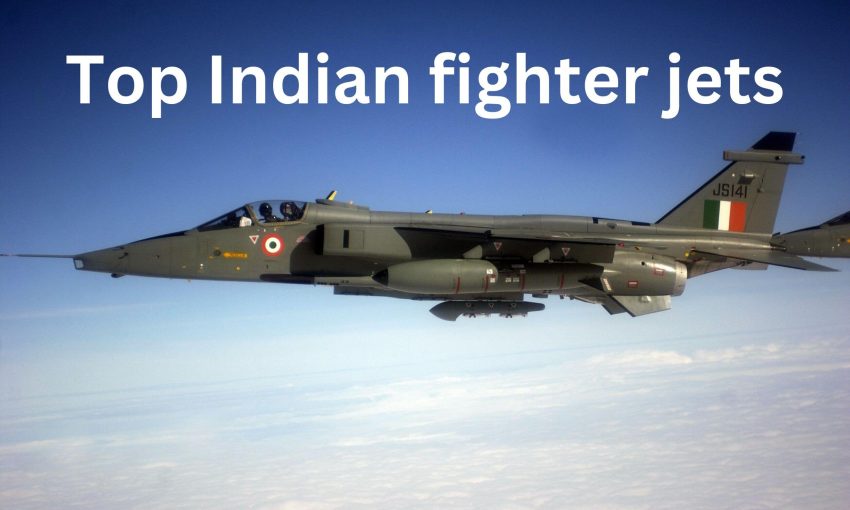About top Indian fighter jets, India is home to some of the most advance fighter jets in the world. From the indigenous Tejas Light Combat Aircraft to the Russian Sukhoi Su-30MKI. India has a wide range of fighter jets in its arsenal. These fighter jets are used by the Indian Air Force (IAF) to protect the country’s airspace. And to carry out missions in support of the Indian armed forces. In this article, we will take a look at some of the top Indian fighter jets and their capabilities.

Analyzing India’s Fighter Jet Procurement Process: Challenges and Opportunities (Top Indian Fighter Jets)
India’s fighter jet procurement process is a complex and challenging endeavor. It involves a number of stakeholders, including the government, the military, and the private sector. The process is also subject to a number of external factors. Such as international politics, economic conditions, and technological advancements. As such, it is important to understand the various challenges and opportunities.That ssociates with India’s fighter jet procurement process.
One of the major challenges associated with India’s fighter jet procurement process is the lack of transparency. This is due to the fact that the process is largely conducted in secret, with little to no public oversight. This lack of transparency can lead to corruption and mismanagement. Which can have serious implications for the country’s security. Additionally, the lack of transparency can also lead to delays in the procurement process, as well as cost overruns.
India’s fighter jet procurement process:
Another challenge associated with India’s fighter jet procurement process is the lack of competition. This is due to the fact that the Indian government has traditionally favored certain domestic companies over foreign ones. Additionally, this lack of competition can also lead to a lack of innovation. As companies may not be incentivized to develop new technologies or improve existing ones.
Finally, India’s fighter jet procurement process is also subject to a number of external factors. Such as international politics, economic conditions, and technological advancements. These external factors can have a significant impact on the process. As they can affect the availability of aircraft, the cost of procurement, and the timeline for delivery.
About opportunities associated with India’s fighter jet:
Despite these challenges, there are also a number of opportunities associated with India’s fighter jet procurement process. For example, the Indian government has recently taken steps to increase transparency and competition in the process.
The result is in a more competitive environment, which can lead to lower prices and higher quality of aircraft. Additionally, the Indian government has also taken steps to encourage innovation and technological advancements. Which can lead to more advanced aircraft and better performance.
Complex and challenging endeavor:
Overall, India’s fighter jet procurement process is a complex and challenging endeavor. It is subject to a number of external factors, as well as a lack of transparency and competition. However, there are also a number of opportunities associated with the process.
Such as increased transparency, competition, and innovation. By understanding the various challenges and opportunities associated with India’s fighter jet procurement process. The country can ensure that it is able to procure the best aircraft for its needs.
The Future of India’s Fighter Jet Program: The AMCA and the FGFA
India is currently in the process of developing two of the most advanced fighter jets in the world: the Advanced Medium Combat Aircraft (AMCA). And the Fifth Generation Fighter Aircraft (FGFA). Both of these aircraft are expected to be game-changers in the Indian Air Force’s (IAF) arsenal. And will be instrumental in helping India maintain its air superiority in the region.
The AMCA is a fifth-generation fighter jet that develops by the Defence Research and Development Organisation (DRDO). The AMCA is expected to be ready for induction into the IAF by 2032.
The FGFA is a joint venture between India and Russia. It bases on the Russian Sukhoi Su-57 fighter jet and is expected to be a fifth-generation fighter jet with advanced avionics and sensors. It expects to be ready for induction into the IAF by 2035.
Helping features of Top Indian Fighter Jets:
The AMCA and the FGFA will be important in helping India maintain its strategic edge in the region. They will be able to provide air cover for Indian forces. And will be able to respond quickly to any threats. They will also be able to provide air support to ground forces and will be able to carry out reconnaissance missions.
Overall, the AMCA and the FGFA are game-changers in the Indian Air Force’s arsenal. They will also be able to carry a range of weapons, including air-to-air missiles, air-to-ground missiles, and air-to-sea missiles.
Examining India’s Indigenous Fighter Jet Program: The Tejas Light Combat Aircraft
India’s Tejas Light Combat Aircraft (LCA) program is an ambitious endeavor.The aim of the program is developing an indigenous fighter jet that can compete with the best in the world. Despite the numerous challenges and setbacks, the program makes significant progress in recent years. And is now on the cusp of entering service with the Indian Air Force.
In this article, we’ll take a closer look at the Tejas LCA program and examine its progress, its capabilities. And its potential impact on India’s defense capabilities.
Tejas LCA program:
The Tejas LCA program was first conceived in the 1980s as a way to reduce India’s dependence on foreign-made fighter jets. The first prototype of the Tejas LCA was unveiled in 2001, and the first production model was given to the Indian Air Force in 2016.
The Tejas LCA is a multi-role fighter jet that is agile and highly maneuverable. It powers a single General Electric F404-GE-IN20 turbofan engine. And is equipped with a variety of advanced avionics and weapons systems. The aircraft is capable of carrying a variety of air-to-air and air-to-ground weapons, including air-to-air missiles, air-to-ground missiles, and bombs.
Advanced electronic warfare suite:
The Tejas LCA is also equipped with an advanced electronic warfare suite. That is designed to detect and jam enemy radar and communications systems. This suite is designed to give the Tejas LCA an edge in air-to-air combat.
The Tejas LCA is a game-changer for India’s defense capabilities. The aircraft designs to be highly maneuverable and capable of operating in all weather conditions. It is also more cost-effective than its foreign-made counterparts.
The Tejas LCA program is a testament to India’s commitment to developing its own defense capabilities. The program faces numerous challenges and setbacks, but it has made significant progress in recent years. The Tejas LCA is a major contributor to India’s defense capabilities in the years to come.
Exploring the Capabilities of India’s Top Fighter Jets: The Su-30MKI and the Rafale
India is home to some of the most advanced fighter jets in the world, and two of the most impressive are the Su-30MKI and the Rafale. Both of these jets are incredibly capable and have been used in a variety of roles, from air superiority to ground attack.
The Su-30MKI is a multi-role fighter jet developed by Russia and India. It is a highly maneuverable aircraft with a range of advanced features. Including an advanced avionics suite, powerful radar, and an array of air-to-air and air-to-ground weapons. The Su-30MKI is capable of engaging multiple targets simultaneously and can use for both air-to-air and air-to-ground missions.
Service period of Rafale French-made jet (Top Indian Fighter Jets):
The Rafale is a French-made fighter jet that is in service since 2006. It is a highly advanced aircraft with a range of features. Including an advanced avionics suite, powerful radar, and an array of air-to-air and air-to-ground weapons. The Rafale is capable of engaging multiple targets simultaneously and can use for both air-to-air and air-to-ground missions.
When it comes to performance, both the Su-30MKI and the Rafale are impressive. The Su-30MKI has a maximum speed of Mach 2.35 and a range of 3,000 km. While the Rafale has a maximum speed of Mach 1.8 and a range of 3,700 km. Both jets are highly maneuverable and can reach altitudes of up to 50,000 feet.
Short description for both Su-30MKI and Rafale jets (Top Indian Fighter Jets):
Overall, both the Su-30MKI and the Rafale are impressive fighter jets with a range of capabilities. The Su-30MKI is a highly maneuverable aircraft with an advanced avionics suite and powerful radar. While the Rafale is a highly advanced aircraft with an advanced avionics suite and powerful radar. Both jets are capable of engaging multiple targets simultaneously and can use for both air-to-air and air-to-ground missions.
In terms of performance, the Su-30MKI has a maximum speed of Mach 2.35 and a range of 3,000 km. While the Rafale has a maximum speed of Mach 1.8 and a range of 3,700 km. In terms of weapons, both jets are equipped with a variety of air-to-air and air-to-ground missiles. As well as laser-guided bombs and precision-guided munitions. Ultimately, both the Su-30MKI and the Rafale are impressive fighter jets that are capable of performing a variety of missions.
The History of India’s Fighter Jet Program: From the MiG-21 to the Tejas
India’s fighter jet program has come a long way since the introduction of the MiG-21 in the 1960s. This Soviet-made aircraft was the first of its kind to be inducted into the Indian Air Force (IAF). And it quickly became the backbone of the IAF’s fighter fleet. The MiG-21 is a reliable and capable aircraft, but it limites in its capabilities and was eventually phased out in the late 1990s.
Since then, India makes great strides in developing its own indigenous fighter jet program. The first of these was the Light Combat Aircraft (LCA) Tejas. It that develops by the Aeronautical Development Agency (ADA) and Hindustan Aeronautics Limited (HAL). The Tejas designs to be a multi-role fighter jet, capable of performing air-to-air combat, air-to-ground strikes, and reconnaissance missions. It also designs to be highly maneuverable and has a low radar cross-section, making it difficult to detect.
Using or service time of Tejas jet:
The Tejas is in service since 2016. It is famous for its performance and reliability, and it has become the mainstay of the IAF’s fighter fleet. The Tejas export to several countries, including the United Arab Emirates and Sri Lanka.
In addition to the Tejas, India has also developed several other fighter jets. Including the Sukhoi Su-30MKI, the Dassault Rafale, and the HAL Tejas Mk2. These aircraft are all highly capable and have been used in various combat operations. Including the 2019 Balakot airstrike against Pakistan.
India’s fighter jet program has come a long way since the introduction of the MiG-21. The country makes great strides in developing its own indigenous fighter jets. The Tejas have become the mainstay of the IAF’s fighter fleet, and India has also developed several other fighter jets. India’s fighter jet program is a testament to the country’s commitment to developing its own defense capabilities.
Conclusion
The Indian fighter jets are some of the most advanced and powerful aircraft in the world. They are capable of performing a wide range of missions, from air-to-air combat to air-to-ground strikes. With their advanced avionics, weapons, and sensors, they are a formidable force in the skies.
The Indian Air Force has been able to maintain its edge in the region by investing in the latest technology. And training its pilots to the highest standards. The Indian fighter jets are a testament to the country’s commitment to air superiority and its ability to defend its borders.
Content from other States:
- No items




